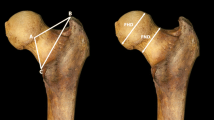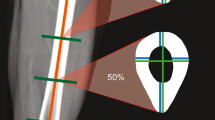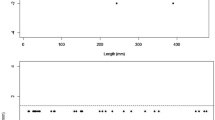Abstract
This paper introduces an automated method for estimating sex from the lower and upper limbs based on diaphyseal CSG properties. The proposed method was developed and evaluated using 389 femurs, 412 tibias, and 404 humeri of adult individuals from a modern Greek reference sample, the Athens Collection. The skeletal properties, which were extracted with the CSG-Toolkit, were analyzed with step-wise DFA (evaluated with LOOCV) and subsequently with RBF kernel SVM supervised learning. SVM cross-validation was based on a 20-fold stratified random sample splitting as well as a chronological split based on year of birth to further assess the effect of secular change in sex estimation capacity. Maximum cross-validated classification accuracy from step-wise DFA reached 94.8% for the femur, 94.7% for the tibia, and 97.3% for the humerus, whereas SVM cross-validated results were similar although slightly lower, mainly due to the more strict cross-validation scheme. Our results suggest that the proposed sex estimation method is reasonably robust to secular change, since there was limited loss in classification accuracy between different chronological groups, despite the presence of secular change in stature of the Greek population during the examined period. The proposed method has been implemented as a function for the GNU Octave environment, named estimate_sex, which comprises a self-intuitive graphical user interface for facilitating sex estimation and is freely available under a suitable license.

Similar content being viewed by others
References
Bruzek J (2002) A method for visual determination of sex, using the human hip bone. Am J Phys Anthropol 117:157–168. https://doi.org/10.1002/ajpa.10012
Phenice TW (1969) A newly developed visual method of sexing the os pubis. Am J Phys Anthropol 30:297–301. https://doi.org/10.1002/ajpa.1330300214
Ubelaker DH, Volk CG (2002) A test of the phenice method for the estimation of sex. J Forensic Sci 47:15200J. https://doi.org/10.1520/JFS15200J
Brůžek J, Santos F, Dutailly B, Murail P, Cunha E (2017) Validation and reliability of the sex estimation of the human os coxae using freely available DSP2 software for bioarchaeology and forensic anthropology. Am J Phys Anthropol 164:440–449. https://doi.org/10.1002/ajpa.23282
Chapman T, Lefevre P, Semal P et al (2014) Sex determination using the Probabilistic Sex Diagnosis (DSP: Diagnose Sexuelle Probabiliste) tool in a virtual environment. Forensic Sci Int 234:189.e1–189.e8. https://doi.org/10.1016/j.forsciint.2013.10.037
Murail P, Bruzek J, Houët F, Cunha E (2005) DSP: a tool for probabilistic sex diagnosis using worldwide variability in hip-bone measurements. Bull Mém Société D’Anthropologie Paris 17:167–176
Quatrehomme G, Radoman I, Nogueira L, du Jardin P, Alunni V (2017) Sex determination using the DSP (probabilistic sex diagnosis) method on the coxal bone: efficiency of method according to number of available variables. Forensic Sci Int 272:190–193. https://doi.org/10.1016/j.forsciint.2016.10.020
Spradley MK, Jantz RL (2011) Sex estimation in forensic anthropology: skull versus postcranial elements. J Forensic Sci 56:289–296. https://doi.org/10.1111/j.1556-4029.2010.01635.x
Anzellini A, Toyne JM (2019) Estimating sex using isolated appendicular skeletal elements from Chachapoyas, Peru. Int J Osteoarchaeol 29:961–973. https://doi.org/10.1002/oa.2810
Charisi D, Eliopoulos C, Vanna V, Koilias CG, Manolis SK (2011) Sexual dimorphism of the arm bones in a modern Greek population. J Forensic Sci 56:10–18. https://doi.org/10.1111/j.1556-4029.2010.01538.x
Duangto P, Mahakkanukrauh P (2020) Sex estimation from upper limb bones in a Thai population. Anat Cell Biol 53:36–43. https://doi.org/10.5115/acb.19.179
Kranioti EF, Michalodimitrakis M (2009) Sexual dimorphism of the humerus in contemporary Cretans-a population-specific study and a review of the literature. J Forensic Sci 54:996–1000. https://doi.org/10.1111/j.1556-4029.2009.01103.x
Moore MK, DiGangi EA, Niño Ruíz FP et al (2016) Metric sex estimation from the postcranial skeleton for the Colombian population. Forensic Sci Int 262:286.e1–286.e8. https://doi.org/10.1016/j.forsciint.2016.02.018
Bertsatos A, Papageorgopoulou C, Valakos E, Chovalopoulou M-E (2018) Investigating the sex-related geometric variation of the human cranium. Int J Legal Med 132:1505–1514. https://doi.org/10.1007/s00414-018-1790-z
Nikita E (2019) Quantitative sex estimation based on cranial traits using r functions. J Forensic Sci 64:175–180. https://doi.org/10.1111/1556-4029.13833
Yang W, Liu X, Wang K, Hu J, Geng G, Feng J (2019) Sex determination of three-dimensional skull based on improved backpropagation neural network. Comput Math Methods Med 2019:1–8. https://doi.org/10.1155/2019/9163547
Bertsatos A, Chovalopoulou M-E, Brůžek J, Bejdová Š (2020) Advanced procedures for skull sex estimation using sexually dimorphic morphometric features. Int J Legal Med 134:1927–1937. https://doi.org/10.1007/s00414-020-02334-9
Čechová M, Dupej J, Brůžek J, Bejdová Š, Horák M, Velemínská J (2019) Sex estimation using external morphology of the frontal bone and frontal sinuses in a contemporary Czech population. Int J Legal Med 133:1285–1294. https://doi.org/10.1007/s00414-019-02063-8
Yang W, Zhou M, Zhang P, Geng G, Liu X, Zhang H (2020) Skull sex estimation based on wavelet transform and Fourier transform. Biomed Res Int 2020:1–10. https://doi.org/10.1155/2020/8608209
Curate F, Coelho J, Gonçalves D et al (2016) A method for sex estimation using the proximal femur. Forensic Sci Int 266:579.e1–579.e7. https://doi.org/10.1016/j.forsciint.2016.06.011
Frutos LR (2005) Metric determination of sex from the humerus in a Guatemalan forensic sample. Forensic Sci Int 147:153–157. https://doi.org/10.1016/j.forsciint.2004.09.077
Šlaus M, Bedić Ž, Strinović D, Petrovečki V (2013) Sex determination by discriminant function analysis of the tibia for contemporary Croats. Forensic Sci Int 226:302.e1–302.e4. https://doi.org/10.1016/j.forsciint.2013.01.025
Ammer S, d’Oliveira Coelho J, Cunha EM (2019) Outline shape analysis on the trochlear constriction and Olecranon fossa of the humerus: insights for sex estimation and a new computational tool. J Forensic Sci 64:1788–1795. https://doi.org/10.1111/1556-4029.14096
Kranioti EF, Nathena D, Michalodimitrakis M (2011) Sex estimation of the Cretan humerus: a digital radiometric study. Int J Legal Med 125:659–667. https://doi.org/10.1007/s00414-010-0470-4
Tallman SD, Blanton AI (2020) Distal humerus morphological variation and sex estimation in modern Thai individuals. J Forensic Sci 65:361–371. https://doi.org/10.1111/1556-4029.14218
İşcan MY, Miller-Shaivitz P (1984) Determination of sex from the Tibia. Am J Phys Anthropol 64:53–57. https://doi.org/10.1002/ajpa.1330640104
Kranioti EF, Tzanakis N (2015) Estimation of sex from the upper limb in modern Cretans with the aid of ROC-analysis: a technical report. Forensic Res Criminol Int J:1. https://doi.org/10.15406/frcij.2015.01.00008
Robinson MS, Bidmos MA (2011) An assessment of the accuracy of discriminant function equations for sex determination of the femur and tibia from a South African population. Forensic Sci Int 206:212.e1–212.e5. https://doi.org/10.1016/j.forsciint.2010.12.009
Ross AH, Manneschi MJ (2011) New identification criteria for the Chilean population: estimation of sex and stature. Forensic Sci Int 204:206.e1–206.e3. https://doi.org/10.1016/j.forsciint.2010.07.028
Spradley MK, Jantz RL, Robinson A, Peccerelli F (2008) Demographic change and forensic identification: problems in metric identification of Hispanic skeletons. J Forensic Sci 53:21–28. https://doi.org/10.1111/j.1556-4029.2007.00614.x
Steyn M, İşcan MY (1997) Sex determination from the femur and tibia in South African whites. Forensic Sci Int 90:111–119. https://doi.org/10.1016/S0379-0738(97)00156-4
Bertsatos A, Chovalopoulou M-E (2020) Advances in osteometric sorting: utilizing diaphyseal CSG properties for lower limb skeletal pair-matching. J Forensic Sci 65:1400–1405. https://doi.org/10.1111/1556-4029.14480
Bertsatos A, Chovalopoulou M-E (2019) A novel method for analyzing long bone diaphyseal cross-sectional geometry. A GNU Octave CSG Toolkit. Forensic Sci Int 297:65–71. https://doi.org/10.1016/j.forsciint.2019.01.041
Eliopoulos C, Lagia A, Manolis S (2007) A modern, documented human skeletal collection from Greece. HOMO 58:221–228. https://doi.org/10.1016/j.jchb.2006.10.003
Bertsatos A, Gkaniatsou E, Papageorgopoulou C, Chovalopoulou M-E (2019) “What and how should we share?” An inter-method inter-observer comparison of measurement error with landmark-based craniometric datasets. Anthropol Anz:109–120. https://doi.org/10.1127/anthranz/2019/1047
Bertsatos A (2020) long-bone-diaphyseal-CSG-Toolkit: A GNU Octave CSG Toolkit. Zenodo
Eaton JW, Bateman D, Hauberg S, Wehbring R (2019) GNU Octave version 5.1.0 manual: a high-level interactive language for numerical computations
Bertsatos A, Chovalopoulou M-E (2018) Validation study of correct operation for the “long-bone-diaphyseal-CSG-Toolkit.” Zenodo
Bertsatos A, Chovalopoulou M-E, Giannaki K, Valakos E (2018) Morphological variation of the femoral head fovea capitis. Eur J Anat 22:397–402
Pedregosa F, Varoquaux G, Gramfort A et al (2011) Scikit-learn: machine learning in Python. J Mach Learn Res 12:2825–2830
JASP Team (2020) JASP (Version 0.12.2)[Computer software]
Brzobohatá H, Krajíček V, Horák Z, Velemínská J (2016) Sexual dimorphism of the human tibia through time: insights into shape variation using a surface-based approach. PLoS ONE 11:e0166461. https://doi.org/10.1371/journal.pone.0166461
Cuzzullin MC, Curate F, Freire AR, Costa ST, Prado FB, Daruge Junior E, Cunha E, Rossi AC (2020) Validation of anthropological measures of the human femur for sex estimation in Brazilians. Aust J Forensic Sci:1–14. https://doi.org/10.1080/00450618.2020.1729411
Chang C-C, Lin C-J (2011) LIBSVM: a library for support vector machines. ACM Trans Intell Syst Technol 2:1–27. https://doi.org/10.1145/1961189.1961199
Bertsatos A, Chovalopoulou M-E (2018) Secular change in adult stature of modern Greeks. Am J Hum Biol 30:e23077. https://doi.org/10.1002/ajhb.23077
Flury B (1997) A first course in multivariate statistics. Springer, New York
Duda RO, Hart PE, Stork DG (2001) Pattern classification, 2nd edn. Wiley, New York
Patriquin ML, Steyn M, Loth SR (2005) Metric analysis of sex differences in South African black and white pelves. Forensic Sci Int 147:119–127. https://doi.org/10.1016/j.forsciint.2004.09.074
Gonen M, Tanugur AG, Alpaydin E (2008) Multiclass posterior probability support vector machines. IEEE Trans Neural Netw 19:130–139. https://doi.org/10.1109/TNN.2007.903157
Li H-X, Yang J-L, Zhang G, Fan B (2013) Probabilistic support vector machines for classification of noise affected data. Inf Sci 221:60–71. https://doi.org/10.1016/j.ins.2012.09.041
Tao Q, Wu G-W, Wang F-Y, Wang J (2005) Posterior probability support vector machines for unbalanced data. IEEE Trans Neural Netw 16:1561–1573. https://doi.org/10.1109/TNN.2005.857955
Author information
Authors and Affiliations
Corresponding author
Ethics declarations
Conflict of interest
The authors declare that they have no conflict of interest.
Code availability
All code of custom built software is licensed under the GNU GPL v3 open source license and is available at GitHub. See manuscript for more details.
Additional information
Publisher’s note
Springer Nature remains neutral with regard to jurisdictional claims in published maps and institutional affiliations.
Rights and permissions
About this article
Cite this article
Bertsatos, A., Garoufi, N. & Chovalopoulou, ME. Advancements in sex estimation using the diaphyseal cross-sectional geometric properties of the lower and upper limbs. Int J Legal Med 135, 1035–1046 (2021). https://doi.org/10.1007/s00414-020-02437-3
Received:
Accepted:
Published:
Issue Date:
DOI: https://doi.org/10.1007/s00414-020-02437-3




